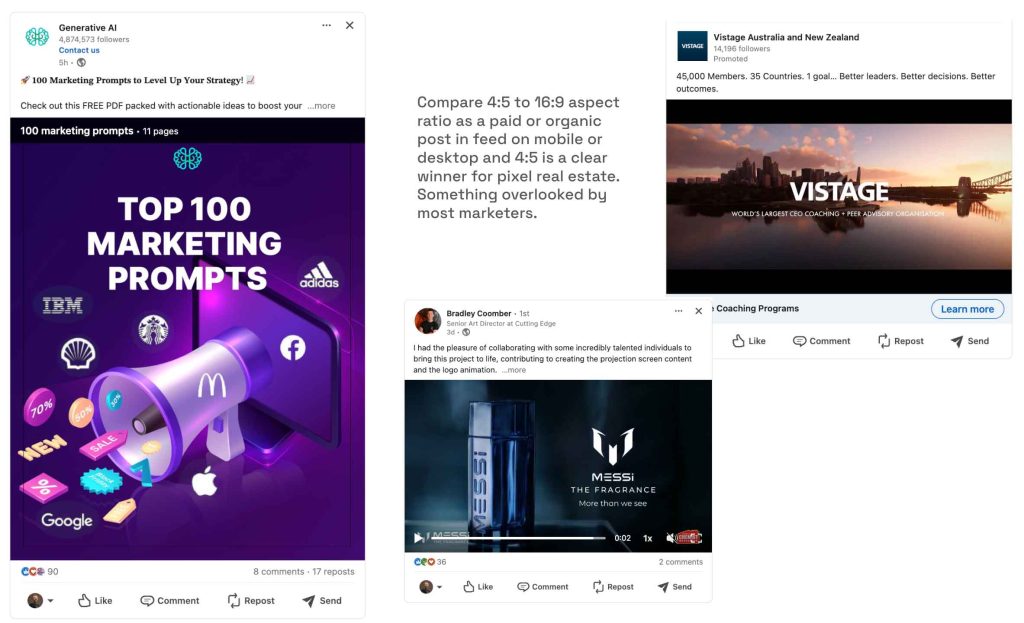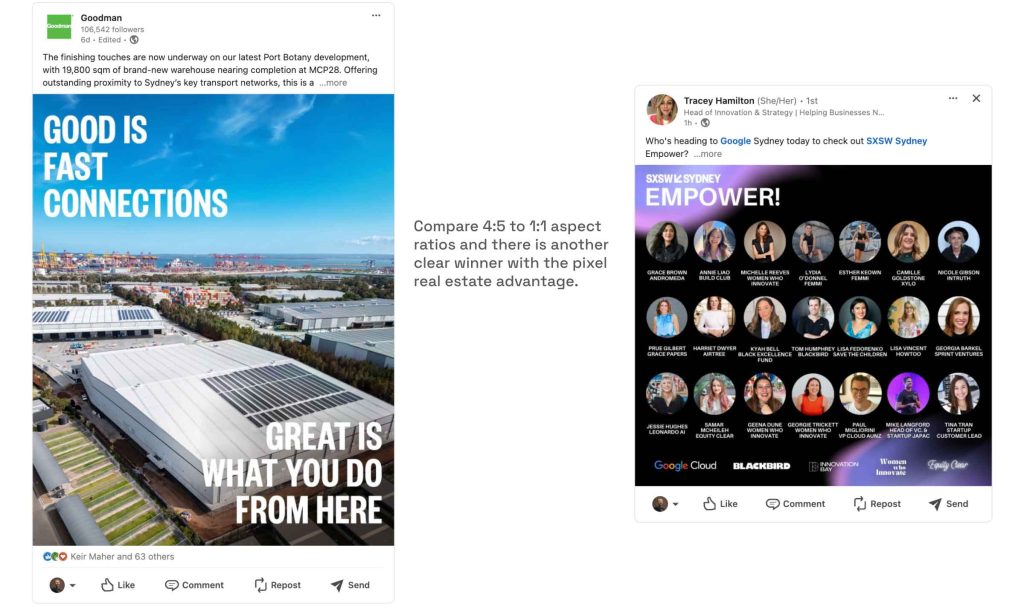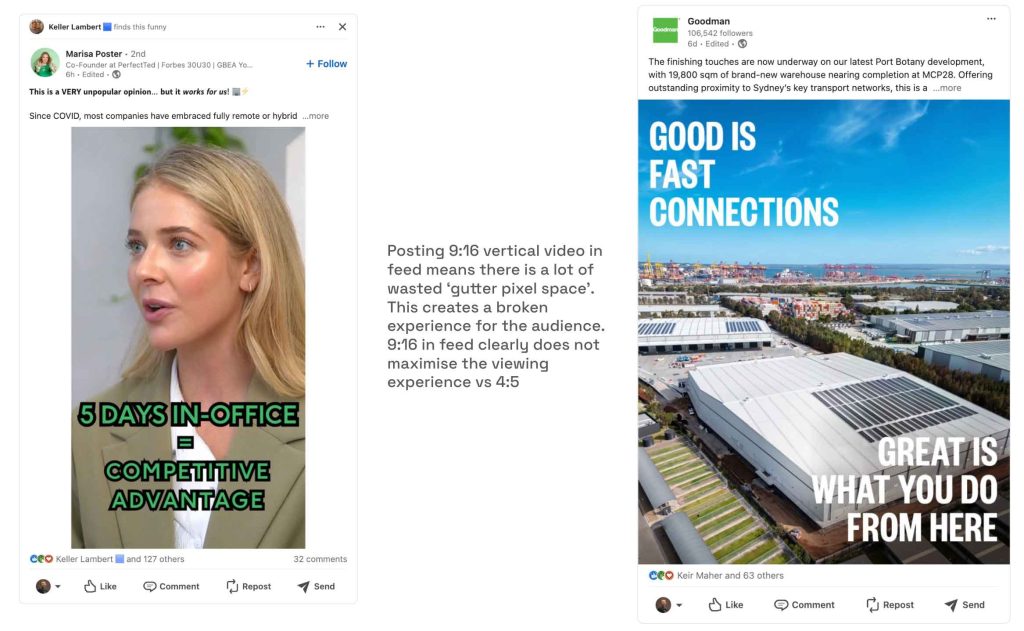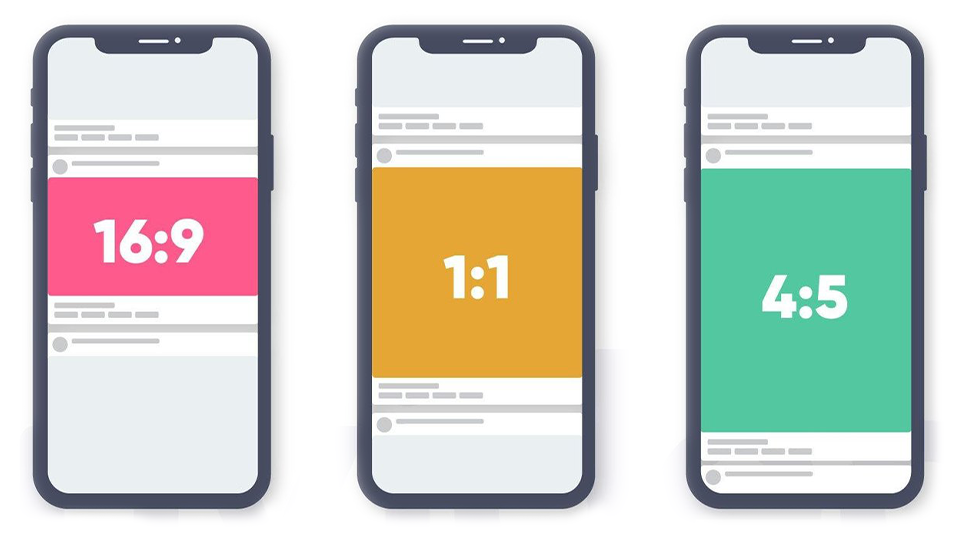Why Size Matters and How Aspect Ratios and Strategic Placement Can Drive Results
In the ever-evolving landscape of digital marketing, LinkedIn has firmly established itself as a key platform for businesses and brands aiming to engage a professional audience. Beyond networking, recruitment, and thought leadership, LinkedIn is a powerful advertising channel. But to truly harness its potential, you need to do more than just post great content—you need to consider how that content is formatted and displayed on users’ screens.
Aspect ratios, the proportional relationship between width and height, play a significant role in this. The decision to use a 4:5, 16:9, 1:1, or even 9:16 aspect ratio in your LinkedIn campaigns can have a significant impact on engagement, visibility and overall effectiveness. In particular, adopting the 4:5 format offers unique advantages across both mobile and desktop, allowing businesses to utilise more pixel space, create stronger visual impact and ultimately drive better results.
Why Aspect Ratios Matter: The Importance of Visual Real Estate
When it comes to digital advertising, how much space your content occupies on-screen can be just as important as what the content says. In a world where attention is fleeting, optimising for screen real estate becomes crucial. On LinkedIn, ads and content can appear in multiple formats: 16:9 (widescreen), 1:1 (square), 9:16 (vertical), and 4:5 (a slightly shorter vertical). Each has its own advantages and disadvantages, but one stands out when it comes to maximising visibility 4:5 wins.
Here’s why.
4:5 Offers More Pixel Space Across Devices
For a long time, the 16:9 aspect ratio dominated video content, largely due to its compatibility with widescreen formats like TV and YouTube. However, the shift to mobile has changed the game. With over 60% of LinkedIn traffic coming from mobile devices, vertical content formats—like 9:16 and 4:5—now hold more attention.

But the real magic of 4:5 is that it provides a perfect middle ground for both mobile and desktop users. On mobile, this aspect ratio occupies a significant portion of the vertical feed, offering more space for your messaging, images, and calls to action. Importantly, on desktop, 4:5 still gives you more pixel space on-screen compared to other formats. This makes it a winning format for campaigns targeting both desktop and mobile users. While 16:9 might work for widescreen video, it can feel underwhelming on mobile feeds. Likewise, 9:16 might dominate on mobile, but it can seem overly stretched and awkward on desktop.
In contrast, the 4:5 ratio strikes the right balance, ensuring your content has enough space to breathe without compromising the viewing experience on either platform. Brands that leverage this format enjoy the benefit of occupying more space in users’ feeds, keeping their content visible for longer and making it more likely to capture attention.
Engagement: Maximising Time in the Feed
Engagement is a key component of all digital marketing. Whether you’re looking for likes, shares, comments or clicks, the key is getting your audience to engage with your content. And engagement is directly linked to how much time your content stays on-screen as users scroll through their LinkedIn feeds. The more space it occupies, the longer it stays visible.
Studies across social platforms like Facebook and Instagram have demonstrated that vertical content—specifically 4:5 or 9:16 formats—tend to drive higher engagement. This is primarily because vertical formats take up more screen real estate, commanding attention for a longer time. As users scroll, they encounter fewer distractions with vertical content compared to horizontal formats like 16:9, where additional ads or posts can easily crowd the frame.
On LinkedIn, adopting the 4:5 aspect ratio allows businesses to deliver content that stands out, ensuring that key information and branding remain prominent on users’ screens for longer, thus increasing the likelihood of interaction.
Strategic Design: Using 4:5 to Maximise Impact
As a full-service agency, our strategy, creative and media teams work collaboratively together, so not only have we observed through media analysis the optimisation that 4:5 aspect ratio brings, we also understand the creative and design benefits. How you use the space matters just as much as the size of the space itself. The 4:5 format allows for more creative freedom in terms of design, messaging and calls to action.

When leveraging 4:5, here’s how you can maximise its potential:
1. Bold Visuals and Messaging: Since 4:5 offers more vertical space, take advantage of this by using eye-catching imagery and clear messaging that’s easy to read. Avoid clutter, but don’t be afraid to use the extra space to highlight key product features, stats, or data that resonates with LinkedIn’s professional audience.
2. Layered Content: With more space comes the opportunity to experiment with multiple layers of content. This could mean a combination of bold headlines, product imagery, and a strong call to action, all of which would be constrained in a more traditional 16:9 format.
3. Infographics and Data Visualisation: LinkedIn’s audience is knowledge-seeking and information-hungry, making it the ideal platform for sharing data and insights. The 4:5 format is great for creating easily digestible infographics or charts, as the extra vertical space allows you to present complex information clearly and effectively.
4. Bolder CTAs: Calls to action are crucial for driving engagement. With 4:5 you can design CTAs that are larger and more prominent, making it easier for your audience to take the next step—whether it’s visiting your website, downloading a whitepaper, or signing up for a webinar.
Another Important Consideration: Avoiding Video Player Controls
While maximising visual space is important, another key consideration, specifically when designing video content for LinkedIn, is ensuring that key information doesn’t get obscured by video player controls. When videos are played on LinkedIn, controls such as play, pause, and the timeline bar sit along the bottom of the video frame. Placing vital information, supers, or graphics behind these controls can significantly diminish the impact of your message.

Best Practices for Graphic Placement in Video
1. Safe Zones: When creating videos, especially in the 4:5 format, always keep in mind the safe zone for text and graphics. Avoid placing crucial information in the bottom third of the screen, as this is where the video player controls will appear.
2. Testing Across Devices: LinkedIn's video controls can appear differently across mobile and desktop. What works on one device might be hidden on another. Ensure you test your video content across devices to see where these controls fall and adjust accordingly.
3. Design for Clarity: Position your text, supers, and graphics higher in the frame so they remain legible and impactful. This is especially important for calls to action—if they’re hidden behind controls, users are far less likely to engage.
By keeping these factors in mind, you can ensure that your video content not only takes advantage of the vertical space provided by the 4:5 format but also remains clear and effective across different devices.
Making the Switch: Best Practices for Adopting the 4:5 Format
Now that we’ve established the benefits of the 4:5 format, how can brands integrate it into their LinkedIn campaigns? Here are some best practices to guide the transition:
1. Design Mobile-First: Always start by designing for mobile devices. LinkedIn’s audience is increasingly mobile, and 4:5 is a format that naturally aligns with this shift. Ensure your content is clear and easy to engage with on smaller screens.
2. Prioritise Simplicity: The additional vertical space provided by 4:5 can tempt marketers to add more content. However, simplicity is key. Prioritise clarity and bold, clean designs to ensure your message isn’t lost in clutter.
3. Experiment with Content Types: The extra space allows for more creative freedom. Try using infographics, layered content, or even animations to capture attention. LinkedIn’s professional audience values information, so don’t hesitate to present data or insights that align with your business goals.
4. Monitor Performance: As with any campaign, continuous improvement is key. Making use of LinkedIn’s analytics tools to measure engagement, clicks, and other key metrics is important. Test different formats and compare the results to see if 4:5 performs better for your brand.
LinkedIn has evolved into a dynamic platform for marketers, offering an audience that is highly engaged, professionally minded, and increasingly mobile. To truly maximise the effectiveness of your campaigns, it's crucial to consider not only the content itself but also how that content is presented. By adopting the 4:5 aspect ratio, you can tap into the power of increased visual real estate across both mobile and desktop, ensuring that your brand's messaging stays front and centre in users' feeds.
The 4:5 format offers an ideal balance, giving your content more vertical screen space while maintaining a clean, professional look that aligns with LinkedIn's user experience. This allows for stronger visuals, clearer messaging, and higher engagement, all while keeping your content accessible across different devices.
At the same time, it’s important to avoid common pitfalls like placing key information behind video player controls, which can detract from the impact of your message. By carefully designing your videos and graphics to fit within safe zones, you can create content that not only looks great but performs effectively.
By embracing these strategies, your LinkedIn campaigns will be more than just another post in the feed—they’ll be visually compelling, strategically optimised, and primed to drive better results. So, whether you're just starting out or looking to refine your approach, making the switch to 4:5 could be the key to unlocking more successful LinkedIn campaigns. We bring this type of thinking to all of our creative and campaign development, you can see some of our recent work here.
Discover how we can maximise your next campaign, drop us a line below:
